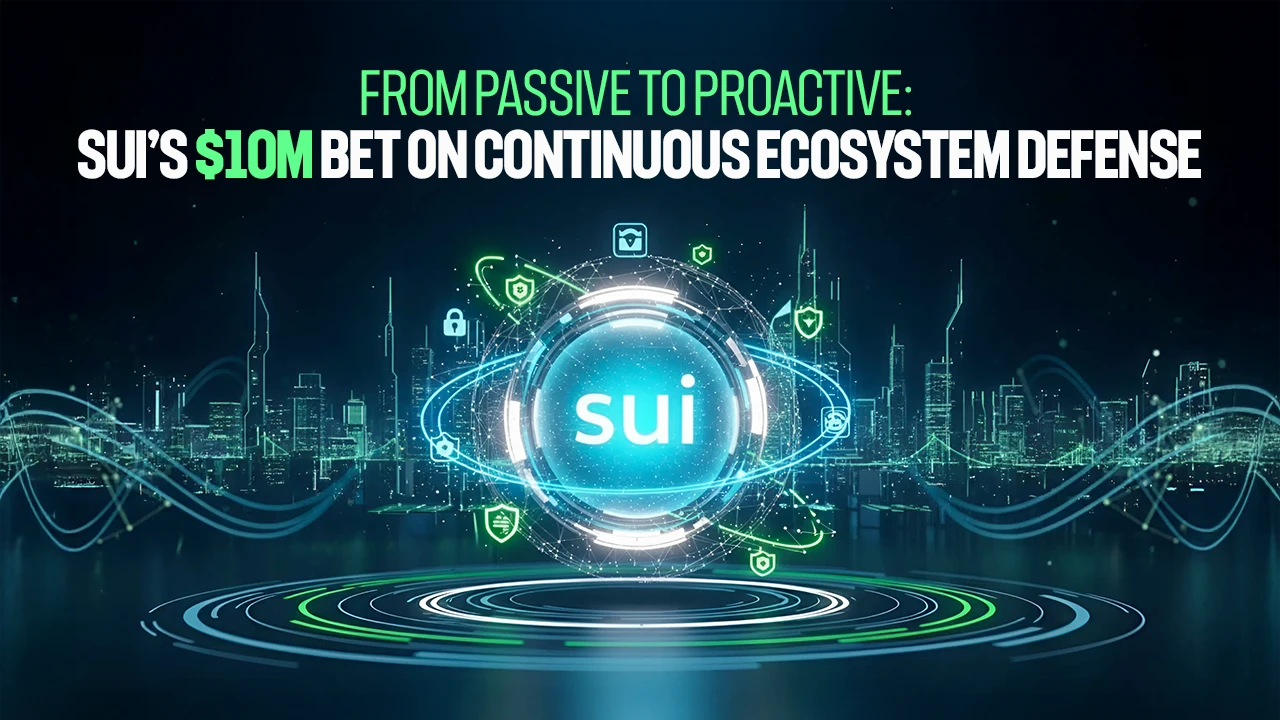Sui Fortifies Defense with a $10M Fund for Wallet-Level Warnings and Real-Time Threat Detection

Sui is moving to raise its ecosystem’s baseline security. The Sui Foundation has expanded a multi-year program, backed by a $10 million commitment, to fund live monitoring, formal verification, and shared defense tooling across wallets, applications, and core infrastructure.
- Sui’s Security Expansion: What Has Changed
- Why This Matters for Investors
- Partners and Tooling: From Monitoring to Formal Methods
- How Sui is Communicating the Shift
- Interaction with Sui’s DPoS Economics
- Adoption and Activity: Baseline Numbers to Track
- Sui By the Numbers
- What to Watch Next
- Wallet Coverage And UX
- Explorer-Embedded Risk Tools
- Formal Verification Uptake
- Partner Ecosystem
- Disclosure and Post-Mortems
- Market Scenarios
- Conclusion
- Frequently Asked Questions About Sui Expanding a $10M Security Program
- How is this program different from traditional audits?
- Which wallets already include transaction simulation?
- Will this change Sui’s consensus or token economics?
- What kinds of threats does monitoring target?
- How will developers use formal verification here?
- Where can I read the official outline?
- Glossary of Key Terms
The aim is practical, to reduce loss events where users actually transact and sign, and make stronger protections standard rather than optional add-ons. The initiative follows months of industry-wide exploits and reflects a belief that risk sits at the edges of the network as much as at the protocol layer.
Sui runs on Delegated Proof of Stake, where validators and delegators share incentives to keep settlement predictable and safe, so the program’s design focuses on the touchpoints that connect DPoS consensus to real users. The Foundation frames the work as moving beyond one-time audits and toward always-on defenses.
ALSO READ: 67.9M ADA Worth $54.3M Exits Coinbase Into 4.19B Whale Wallet Without Delegation
Sui’s Security Expansion: What Has Changed
Sui’s announcement describes four pillars. First, shielding end-users by expanding impersonation detection, transaction simulation in supported wallets, and malicious app flagging before a signature occurs.
Second, ecosystem-wide visibility, using exploit monitoring, alerts for teams, and explorer-integrated tools like risk scores and transaction graphs.
Third, advanced protocol security, including exploit simulations and expanded access to Move Prover for formal verification of critical smart-contract logic.
Fourth, secure development standards, with secure-by-default contract templates for teams to adopt early. The Foundation’s language is direct, and audits remain necessary, but they are not sufficient to stop live attacks that evolve after deployment.
Independent outlets corroborated the program and its scope. Coverage highlights the multi-year horizon, the focus on always-on monitoring, and the goal of raising the baseline for builders rather than subsidizing isolated fixes.
Several reports link the expansion to a broader market shift toward proactive defenses, including protocol-level visibility and ecosystem coordination when incidents surface.
The Foundation and partners have also pointed to concrete integrations. Wallets such as Slush, OKX, and Backpack already support transaction simulation that previews contract effects before a user signs.
The announcement indicates that simulation and risk signals will reach more wallets and user interfaces over time, and that explorer tooling will embed attribution and risk views for faster triage across the community.
Why This Matters for Investors
Security is now a competitive feature for consumer blockchains. The majority of Web3 losses occur above the base layer, often through phishing, impersonation, approval traps, or logic errors in smart contracts.
Sui’s move targets those vectors with live monitoring and formal methods, both of which shorten the window between a bug’s existence and its exploitation. The Foundation is explicit about building an ecosystem defense posture, not a marketing promise.
ALSO READ: Sui Tests Wearables, XDC Foresees $7T in Tokenization, and ARK Buys Tech Stocks
That stance matters for adoption because most new users encounter crypto through wallets, marketplaces, or games, not through protocol code. If everyday actions feel safer, retention improves, and teams can scale without relying on ad-hoc incident response.
The approach also aligns with Sui’s DPoS model. Delegators are sensitive to tail risks that can drain protocols or damage brands. Tools that reduce exploit severity or prevent unsafe signatures help preserve fee revenue, which ultimately feeds validator rewards and staking income. In that way, a dollar spent on shared defenses can protect multiple revenue lines at once.
https://x.com/movebrah/status/1972690417167561040
Partners and Tooling: From Monitoring to Formal Methods
The expansion cites practical techniques rather than slogans. On the monitoring front, security firms describe real-time threat detection, pre-transaction checks, and dashboards that surface risky addresses, drainer patterns, or cross-bridge anomalies before funds move.
Coverage notes Sui’s use of continuous monitoring to complement audits, with a focus on bridges, multisig and MPC wallets, and treasury movements, all frequent targets in recent incidents.
Formal methods play a distinct role. Move Prover can mathematically verify properties of smart contracts written in Move, Sui’s language, reducing classes of logic errors that static analysis might miss.
The initiative will expand access to this tooling, along with exploit simulations that model adversarial behavior before mainnet deployment. That mix suits consumer applications where transaction throughput is high and UX design must assume limited user time to investigate risks manually.
How Sui is Communicating the Shift
Sui’s public messaging frames the program as an air-traffic-control layer for the ecosystem, not a checklist. The Foundation has summarized the goal as funding enterprise-grade defenses and making them accessible to teams building on Sui, with a $10 million pool earmarked for the work. Developers and contributors amplified the message with clear language around audits not being enough and the need for live risk signals in user workflows.
https://x.com/SuiNetwork/status/1972647629063676262
Where the Losses Have Been, and What Changes with the New Model
The program cites industry loss data in the first half of 2025 and focuses on the places where users interact with the chain. Phishing and impersonation attacks target brand names and UI surfaces, not consensus. Approval scams exploit user attention, not to validate honesty.
Complex contracts can fail under edge cases that simple unit tests miss. In each case, the remedy is different. Takedowns and impersonation monitoring reduce exposure windows for lookalike domains. Transaction simulation lowers the chance of a harmful signature.
Formal verification and simulation catch logic errors before deployment. Explorer-level attribution spreads awareness and curbs repeat victimization. The objective is not a claim of perfect safety; it is to make each step safer and to detect failures faster.
ALSO READ: TRON Sets New Records in USDT Transfers as Sui Activates Google Payment Agents
Interaction with Sui’s DPoS Economics
DPoS ties network health to staking behavior. If builders and users perceive lower tail risks, stake tends to consolidate around validators with strong performance and security posture.
Lower exploit frequency should support steadier usage and fee generation, which in Sui’s model is a key component of validator and delegator returns after early subsidies decline.
The Foundation’s materials and third-party documentation underscore this linkage: voting power reflects stake delegated by holders, and rewards are drawn from gas fees and protocol economics. A safer ecosystem supports both.
Adoption and Activity: Baseline Numbers to Track
Security initiatives are only as credible as the usage they protect. On-chain data aggregators track Sui’s usage and liquidity. Recent snapshots show stablecoin capitalization, throughput revenue, and volumes that indicate active demand for DeFi and trading tools on the network.
For investors, the blend of growth and security posture is the point; it is easier to argue for consumer-scale adoption when UX includes pre-signature warnings, risk scores, and standards that lower project-level error rates.
Sui By the Numbers
| Metric | Latest Reading |
| Stablecoins outstanding | $555.48 million |
| DEX volume, 24h | $526.13 million |
| Perpetuals volume, 24h | $84.38 million |
| App fees, 24h | $426,137 |
| Chain fees, 24h | $18,116 |
| Bridged TVL | $1.987 billion |
| Native TVL | $1.647 billion |
Source: DefiLlama chain dashboard for Sui. Figures are point-in-time snapshots and change over time. (DeFi Llama)
What to Watch Next
Wallet Coverage And UX
Transaction simulation already appears in Slush, OKX, and Backpack. The pace at which other wallets add simulation and risk banners will shape user behavior. Broad coverage lowers the chance that an unprotected interface becomes the weakest link.
Explorer-Embedded Risk Tools
If explorers add attribution, risk scores, and visualizations, incident response speeds up and the community can flag high-risk flows in real time. Public visibility helps users avoid repeat interactions with compromised addresses.
Formal Verification Uptake
Expanding Move Prover access and education could shift default developer habits. Progress should show up in audits, with fewer severe bugs and fewer logic-driven loss events.
Partner Ecosystem
Monitoring vendors and phishing-defense platforms move faster when integrated at the foundation level. Watch for partners that extend coverage from smart contracts to bridges and custody stacks, where losses have been larger.
Disclosure and Post-Mortems
If the program works, incident reports should arrive faster, with clearer timelines and mitigations. Transparency builds trust and helps teams learn from others’ mistakes, not only their own.
Market Scenarios
Security becomes a user-level feature when wallets and explorers standardize simulation and risk scores. Phishing losses decline, projects market security alongside fees and speed, and the headline count on exploits falls. As confidence rises, risk budgets for consumer apps expand. Sui’s DPoS model benefits from steadier fees and stake flows that favor validators with strong operational practices.
ALSO READ: ARK Invest Returns to Alibaba After a 4-Year Hiatus as Europe AUM Crosses 1B Mark
Fragmented adoption slows impact if coverage stays uneven. Users face mixed experiences, attackers route through weaker interfaces, and loss events keep shaping perception. Formal verification and simulation help, but the gap between protected and unprotected surfaces limits near-term gains. In this path, security remains a cost center for individual teams rather than a network asset.
New attack paths test monitoring as defenses improve. Adversaries lean on social vectors or cross-ecosystem routes. Monitoring catches more issues early, yet teams still need clear playbooks, rapid disclosures, and paused-contract mechanisms. Success is measured not by zero incidents, but by shorter exploit windows, smaller losses, and faster recovery.
Conclusion
Sui’s security expansion is designed for where risk lives, at the user interface, at the contract boundary, and inside an ecosystem where speed and composability introduce new attack paths. The Foundation’s plan builds on a $10 million allocation and emphasizes continuous tools, not just pre-launch reviews.
The components are concrete, wallet simulation, phishing and impersonation takedowns, exploit monitoring, explorer-level risk views, and formal verification for critical code. The work also maps to Sui’s Delegated Proof of Stake (DPoS) design, which ties user safety to validate economics through fee revenue and stake flows.
For investors, the next step is adoption, how quickly wallets, explorers, and teams standardize these protections, and whether loss events shrink in frequency and size. If the tools become default, not optional, Sui’s pitch to mainstream users strengthens, and its transaction and fee lines should reflect that.
Frequently Asked Questions About Sui Expanding a $10M Security Program
How is this program different from traditional audits?
Audits check code at a point in time. Sui’s program adds live monitoring, transaction simulation, phishing detection, and explorer risk tools. The goal is continuous protection rather than one-off reviews.
Which wallets already include transaction simulation?
The Foundation lists Slush, OKX, and Backpack, with plans to expand to more wallets. Simulation shows users what a contract will do before they sign.
Will this change Sui’s consensus or token economics?
No change to the consensus is implied. Sui operates a Delegated Proof of Stake model, where voting power tracks stake delegated to validators. Better security should support steadier fees and staking dynamics.
What kinds of threats does monitoring target?
Smart-contract exploits, drainer patterns, malicious approvals, risky bridges, and suspicious treasury flows. The aim is to flag and respond before or during an attack, not only after funds move.
How will developers use formal verification here?
Teams can apply Move Prover to validate critical contract properties. This reduces logic errors that normal testing may miss, especially in high-value modules.
Where can I read the official outline?
The Sui Foundation blog provides the full plan and rationale. Several outlets summarize the key points and context.
Glossary of Key Terms
- Delegated Proof of Stake (DPoS): Token holders delegate stake to validators, aligning incentives for secure, predictable settlement.
- Transaction Simulation: A pre-signature preview that shows what a smart contract will do if signed.
- Formal Verification: Mathematical proofs to validate contract properties using tools like Move Prover.
- Impersonation Detection: Monitoring and takedowns for lookalike domains and fake brand accounts.
- Explorer-Integrated Risk Tools: Risk scores, graphs, and attribution embedded in block explorers.
- Exploit Monitoring: Real-time detection and alerts for suspicious on-chain behavior.
- MPC Wallets: Multi-party computation wallets that split signing across parties to reduce single-key risk.
- Move Prover: A tool for verifying programs written in the Move language used on Sui.
- Bridged TVL: Assets locked on Sui that originate from other chains.
- App Fees: Fees generated by applications, a component of network-level revenue.




